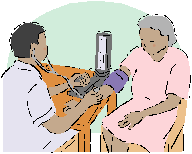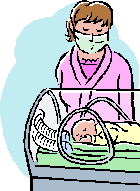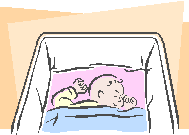DOH Medicaid Update October 2005 Vol. 20, No. 11
Office of Medicaid Management
DOH Medicaid Update
October 2005 Vol. 20, No. 11
State of New York
George E. Pataki, Governor
Department of Health
Antonia C. Novello, M.D., M.P.H., Dr. P.H.
Commissioner
Medicaid Update
is a monthly publication of the
New York State Department of Health,
Office of Medicaid Management,
14th Floor, Room 1477,
Corning Tower, Albany,
New York 12237
Table of Contents
2005 Guidance on HIV Counseling, Testing and Laboratory Reporting Requirements
MOMS Providers - Proper Completion of Claim Forms
Blood Product Billing - Effective October 1, 2005
All Providers: Seminar Schedule and Registration Reminder
Medical-Surgical Supplies (Haberman Feeder)
Patient Educational Tools: Diabetes and Stroke - Are You At Risk?
National Provider Identifier (NPI)
All Providers: Electronic Remittance Advices
Palivizumab Medicaid Coverage for Children at Risk for Respiratory Syncytial Virus Infections
Registered Physician's Assistant Services
Billing for Supernumerary Teeth
Using Vacancy Rate and Census to Determine Bed Reservation Payment Eligibility
Orthodontists: Claim Format
Correction to July Article on Dental Quadrant Designations
PDN Providers: Effective November 1 - Faxed or Mailed Nursing Assessments No Longer Accepted
Provider Services
ATTENTION ALL
PROVIDERS
eMedNY UPDATE!

eMedNY Transition
Extended To
December 31, 2005
Return to Table of Contents
Since the end of the eMedNY transition period on June 20, 2005, some providers have been permitted to continue to submit:
- legacy two-digit locator codes and license type codes instead of the eMedNY-required three-digit locator codes and profession codes, and;
- an eight-digit prior authorization (PA) number, even in cases where an eleven-digit number had been assigned.
The purpose for the accommodation, with a deadline of September 15, was to give providers additional time to complete their eMedNY conversions.
As announced in a letter sent to all providers in August, the Department has agreed to extend the compliance date to December 31, 2005. This decision was a result of communications with a number of our providers who expressed serious concerns about their ability to complete their eMedNY conversion by September 15.
The Department's decision to extend the September 15 date should not be viewed as an opportunity to curtail or delay eMedNY conversion efforts. On the contrary, it is an opportunity to complete the eMedNY conversion without needing to worry about the Medicaid revenue stream.
We expect that those affected will expedite their conversion efforts and be compliant well in advance of December 31, 2005. The December 31, 2005 date is final. After that date:
- eMedNY will accept only the three-digit locator codes,
- License numbers must be preceded by three-digit profession codes,
- Claims submitted with the legacy two-digit locator code and/or two-digit license type code will be rejected, and
- Eight-digit PA numbers will be accepted only when an eight-digit number had been issued.
Providers who have not been able to convert their billing system to accommodate the Phase II required changes are urged to expedite their efforts. If you purchase software from a vendor, or utilize services of a clearinghouse or a billing service, you should contact them immediately and make sure they are aware of the eMedNY's requirements.
Questions? Need additional assistance or support? Please contact the CSC Provider Services at (800) 343-9000.
2005 Guidance on HIV Counseling,
Testing and Laboratory Reporting Requirements
Return to Table of Contents
The New York State Department of Health (NYSDOH) has announced important changes in its policy guidance for HIV counseling and testing.

Why?
According to the Centers for Disease Control and Prevention (CDC), up to 25% of persons living with HIV do not know they are infected and have never been tested. About 40% of patients diagnosed with HIV progress to AIDS within one year. Now, more than ever, it is important to make HIV testing more routine in more settings to make sure people know their HIV status.
What?
To encourage HIV testing more broadly, NYSDOH, consistent with the CDC, urges HIV testing to be recommended as a routine part of medical care. Health care providers in New York State are encouraged to routinely discuss HIV with their patients, regardless of their perceived risk, and to have a low threshold for recommending HIV testing since not all infected persons are aware of or willing to disclose their risk. Health care providers should recommend HIV testing, as appropriate, to all sexually active persons, persons with a history of substance abuse and persons in areas with high seroprevalence (i.e., at least 1%), including major urban areas.
Health care providers are encouraged to adopt rapid testing technology. Rapid HIV tests are simple to use and require little or no specialized equipment. Rapid HIV antibody tests can provide a result during a single appointment.
How?
To be able to encourage HIV testing more routinely, the NYSDOH developed a simplified Informed Consent form. The new form includes an informational pamphlet that can be kept by the patient/client and a signature page that is maintained by the provider. The new Informed Consent form also includes authorization for other HIV-related testing to monitor the HIV epidemic.
To expedite access to care for those who test HIV-positive, the NYSDOH has improved the HIV Medical Information Release form. The form now allows for release of both HIV-related and general medical information to more than one provider at a time. The form also allows for authorizing providers to exchange information between and among themselves.

What are the new laboratory reporting requirements?
Improvements in laboratory reporting are required with the publication of emergency regulations effective June 1, 2005. Electronic laboratory reporting of the results of resistance testing, viral load and CD4 tests is essential to improve monitoring of patients' HIV care and provide a more comprehensive HIV public health surveillance system.
For more information...
To learn more about the 2005 Guidance on HIV Counseling, Testing and Laboratory Requirements, and to download versions of the new Informed Consent and Release forms, go to:
http://www.nyhealth.gov/diseases/aids/regulations/2005_guidance/index.htm
Additional information about rapid testing is also available on the NYSDOH web site at:
http://www.nyhealth.gov/diseases/aids/testing/rapid/index.htm
Information about the HIV Primary Care Medicaid Program and the HIV Enhanced Fees for Physicians Program may be found in the "Reimbursement for HIV Counseling and Testing" section of the NYSDOH web site at:
http://www.nyhealth.gov/diseases/aids/testing/
ATTENTION
MEDICAID
OBSTETRICAL AND
MATERNAL SERVICES
PROVIDERS

PROPER COMPLETION OF CLAIM FORMS
Return to Table of Contents
When submitting claims under the Medicaid Obstetrical and Maternal Services (MOMS) Program, the indicator in the family planning field must be set to "NO".
Federal Policy
Federal Centers for Medicare and Medicaid Services (CMS) policy identifies the types of recipients that are eligible to receive family planning services. Policy dictates that a pregnant woman cannot receive family planning services.
Recent Audit Findings
A recent CMS audit, however, identified MOMS Program provider claims where pregnant women received prenatal care and the family planning indicator was set to "YES". This billing error did not result in inappropriate payment to the provider, but it did result in the State claiming an inappropriate amount of money from the federal government for these services.
The Office of Medicaid Management will develop payment edits to correct the federal claiming errors. In the interim, we request that providers insure that the Family Planning Indicator on MOMS Program claims is properly completed, i.e., set to "NO".
Questions? Please contact the Bureau of Policy Development and Agency Relations at (518) 473-2160.
ATTENTION
PHARMACY PROVIDERS

Blood Product Billing
Change to Billing Units
Return to Table of Contents
Currently blood products are billed by pharmacy providers using a conversion factor of one billing unit to ten clinical units (e.g., 1000 units would be billed as quantity of 100).
This will no longer be required!
Effective October 1, 2005 blood products billed by pharmacies must be billed as the total number of units dispensed (e.g., 1000 units would be billed as quantity of 1000).
Please make appropriate modifications to your billing systems to reflect this change.
NOTE: This revision does not apply to Ordered Ambulatory billing.
Questions? Please contact Computer Sciences Corporation at (800) 343-9000.
ATTENTION
ALL PROVIDERS:
eMedNY Training
Reminder!
Seminar Schedule and Registration
Return to Table of Contents
Computer Sciences Corporation (CSC) announces a schedule of seminars to be offered to providers and their billing staff.
Seminar locations and dates are available at the eMedNY website. Registration is fast and easy.

Go to http://www.emedny.org/training/index.aspx to register for the eMedNY Training Seminar appropriate for your provider category and location.
If you are unable to access the internet to register, please contact CSC's call center at (800) 343-9000 to obtain a registration form. You may also request seminar schedule and registration information by contacting CSC's Fax on Demand at (800) 370-5809.
Please refer to these resources frequently for additional seminar offerings.
CSC representatives look forward to meeting with you at upcoming seminars!
Medical-Surgical Supplies
(Haberman Feeder)
Return to Table of Contents
The Medicaid fee for S8265 #Haberman feeder for cleft lip/palate has been changed to $19.13, effective for dates of service on or after January 1, 2005.
Please note this change in your DME or Pharmacy Fee Schedule (Rev. 4/04 and 4/05).
Questions may be referred to the Bureau of Medical Review and Payment at (518) 474-8161.

PATIENT EDUCATIONAL TOOLS
Return to Table of Contents
This month's Patient Educational Tools features
an article on
"Diabetes and Stroke: Are You At Risk?"
The Medicaid program encourages practitioners to copy and distribute the following information to their patients and to share it with their colleagues.
DIABETES AND STROKE:
ARE YOU AT RISK?
What does Diabetes have to do with Stroke?

If you are a diabetic, you are at a much higher risk for stroke. Stroke is a condition in which blood supply to your brain becomes limited or blocked. This can cause brain tissue damage which can cause serious physical disabilities.
What are signs & symptoms of a Stroke?
- Difficulty speaking, sudden confusion
- Numbness or weakness on one side of your body
- Severe headache, dizziness
- Difficulty with eyesight
- Trouble walking or maintaining balance
If you experience or see others experience any of these symptoms, seek medical attention immediately!
What can I do to lower my risks of stroke?

You can lower your risks by taking these simple steps toward better health:
- Monitor & keep your blood sugar under control, high blood sugar increases your risks
- Careful monitoring & regulating of blood pressure
- Monitor cholesterol
- If you smoke, quit
- Exercise regularly
- Eat healthy
Being aware and taking some simple steps can reduce your risk of stroke and other serious cardiovascular diseases.
Source: The American Diabetes Association, "Make The Link, Heart Disease & Stroke 03/04, toolkit No.21."
For more information on Diabetes and Stroke, you can visit the following websites:
- http://www.health.state.ny.us/diseases/conditions/diabetes/index.htm or call the Diabetes Prevention and Control Program at (518) 474-1222.
- American Diabetes Association http://www.diabetes.org
- American Stroke Association http://www.strokeassociation.com
The New York State Medicaid program reimburses for medically necessary care, services, and supplies needed in the diagnosis and treatment of diabetes. For information regarding Medicaid payment of these services, please contact the Bureau of Program Guidance at (518) 474-9219.
National Provider Identifier
Return to Table of Contents
What Is It?
- The National Provider Identifier (NPI) is the standard unique health identifier for health care providers. It was mandated by the Health Insurance Portability and Accountability Act of 1996 (HIPAA).
- The Final Rule adopting the NPI as the standard unique health identifier for health care providers was published by the Department of Health and Human Services on January 23, 2004.
- The rule became effective on May 23, 2005. On this date, covered providers began applying for NPIs.
- The compliance date for all covered entities, except small health plans, is May 23, 2007; the compliance date for small health plans is May 23, 2008.
- Anyone who meets the definition of a Health Care Provider (160.103 of the Final Rule) may need a NPI.
What Will the NPI Do?
- Replace the use of all legacy provider identifiers (e.g., UPIN, Medicaid Provider Number, Medicare Provider Number, Blue Cross and Blue Shield Numbers) in HIPAA standard transactions as of the compliance dates.
- Simplify transactions, including claims and coordination of benefits.
- May save money in the long term.
What Will the NPI Not Do?
- Guarantee reimbursement by health plans.
- Enroll providers in health plans.
- Make providers covered entities.
- Require providers to conduct electronic transactions.
What Does the NPI Look Like?
- The number (NPI) is 10 positions (9 plus the check-digit), all numeric.
- It does not itself convey information about the provider. Accordingly providers do not have to change NPI when they change geographical locations or change their type of entity.
How Do I Obtain a NPI ?
- Apply for a NPI through a web-based application process at https://nppes.cms.hhs.gov
- Prepare a paper application. Access the above website for necessary information.
- Inclusive information related to the NPI may be found at http://www.cms.hhs.gov/hipaa/hipaa2, email askhipaa@cms.hhs.gov , or call the CMS HIPAA hotline at (866) 282-0659.
ATTENTION
ALL PROVIDERS

ELECTRONIC REMITTANCE ADVICES
eMedNY TRANSACTIONS 820 AND 835
Return to Table of Contents
eMedNY HIPAA remittance advices (820 and 835 transactions) may be delivered as electronic response files through the eMedNY eXchange or FTP. To sign up for electronic remittance visit:
Paper Claim Forms
Providers who submit paper claim forms have the alternate choice of having information returned to them on either a paper remittance advice or on an 820/835 remittance transaction.
To have paper claims reported on an electronic remittance, please contact Enrollment Support at the number below.
Electronic Claims
Providers who submit claims electronically using an Electronic Transmitter Identification Number (ETIN) also have the option of having those claims reported on a paper remittance advice or returned on a 820/835 remittance transaction.
A provider who submits claims under multiple ETINs, that are all set to an electronic media type, will receive multiple 820/835 transactions and multiple checks; i.e., one advice and one check for each ETIN. Additionally, remittance advices (electronic or paper) will contain a maximum of 10,000 claim lines. Any excess will be carried over to additional remittance advice(s). Each remittance advice will have a corresponding check.
Retroactive Rate Changes for Rate-Based Claims
Retroactive rate changes for rate-based claims will be delivered to the electronic or paper remittance which is based on the ETIN and the provider ID combination as submitted with the original claim, using your current remittance distribution selection for that ETIN.
Questions? Please call Computer Sciences Corporation at (800) 343-9000, Option 5.
Fraud impacts all taxpayers.
Return to Table of Contents
Do you suspect that a recipient or a provider has engaged in fraudulent activities?
Please call:
1-877-87FRAUD
Palivizumab (Synagis®) Medicaid Coverage
For Children at Risk for Respiratory Syncytial Virus Infections
Return to Table of Contents

Palivizumab is an intramuscular injection used as prophylaxis for respiratory syncytial virus (RSV). It is used in certain high-risk children with histories of prematurity and chronic lung disease (CLD) (formerly known as bronchopulmonary dysplasia). RSV is a leading cause of bronchiolitis and pneumonia in infants. Palivizumab should be administered at the start of the season, typically November, and monthly throughout the RSV season, ending in April.

GUIDELINES
The following are guidelines for identifying children who should be considered for RSV prophylaxis and are adapted from the American Academy of Pediatrics' Policy Statement 1:
- Infants and children less than 24 months of age with CLD who have required medical therapy for CLD within the past six months before the anticipated start of the RSV season.
- Neonates born at greater than 28 weeks and less than 32 weeks gestation with or without CLD who are less than six months of age at the start of the RSV season.
- Neonates born at 28 weeks of gestation or less with or without CLD and who are less than 12 months of age at the start of the RSV season.
- Neonates born between 32 and 35 weeks gestation with or without CLD who are less than six months of age at the start of the RSV season only if two or more additional risk factors are present including: school-age siblings, child-care attendance, exposure to environmental air pollutants, congenital abnormalities of the airways or severe neuromuscular disease.
- Children who are 24 months of age or younger with hemodynamically significant cyanotic and acyanotic congenital heart disease.
Palivizumab should not be used for the treatment of RSV disease.
REIMBURSEMENT AND PAYMENT
Medicaid reimburses for Palivizumab when billed by Medicaid-enrolled physicians, nurse practitioners and pharmacy providers.
Practitioner Billing
When billing the cost and administration of Palivizumab, physicians and nurse practitioners should:
- Use code 90749 (unlisted vaccine/toxoid), and include a copy of the invoice attached to the claim.
- Describe the product name and total dose administered on the claim form.
- Insert the acquisition cost plus a two-dollar ($2.00) administration fee in the "amount charged" field.
For more information on practitioner billing, see the Physician Provider Manual, Procedure Code and Fee Schedule page 109, version 2005-1 (4/1/05), available at:
http://www.emedny.org/ProviderManuals/Physician/index.html
Pharmacy Billing
Pharmacy providers should enter the Palivizumab NDC number into the on-line billing system as they would for any prescription pharmaceutical.
For further information on Medicaid coverage guidelines of Palivizumab, please contact staff:
Physician providers: (518) 473-2160
Pharmacy providers: (518) 486-3209
For billing questions, please contact Computer Sciences Corporation at (800) 343-9000.
References:
- American Academy of Pediatrics, Committee on Infectious Diseases and Committee on Fetus and Newborn. Policy statement: revised indications for the use of palivizumab and respiratory syncytial virus immune globulin intravenous for the prevention of respiratory syncytial virus infections. http://www.aap.org/policy/rsvpolicy.pdf
- American Academy of Pediatrics, Committee on Infectious Diseases and Committee on Fetus and Newborn. Prevention of respiratory syncytial virus infections: indication for the use of palivizumab and update on the use of RSV-IGIV. Pediatrics. 1998;102:1211-1216.
- Meissner HC, et al. Prevention of RSV infection in high risk infants: Consensus opinion on the role of immunoprophylaxis with palivizumab, a humanized respiratory syncytial virus monoclonal antibody for prevention of respiratory syncytial virus infection in high risk infants. Pediatr Infect Dis J. 1999;18 (3):223-231.
- Synagis® (palivizumab) prescribing information. Medimmune, Inc., Rev. Date Dec. 14, 2004.
(Rev. 8/05)
Orthodontia Prior Approval Numbers
on eMedNY Claim
Return to Table of Contents
When billing for all Medicaid recipients who reside in counties outside of New York City, Nassau or Suffolk Counties:
All claims for orthodontic treatment for procedure codes D8070, D8080, D8090, D8670 or D8680 with a date of service of January 1, 2006 or after MUST have the 8 or 11-digit prior approval number, issued by the Department of Health, entered in item 19 on the claim form, or the claim will automatically be denied. If entering an 8-digit PA Number, you must enter the number in the first eight spaces and leave the last three spaces blank.

REGISTERED PHYSICIAN'S ASSISTANT SERVICES
Return to Table of Contents
What is a Registered Physician Assistant?
A Registered Physician's Assistant (RPA) is considered a dependent practitioner working under the supervision of a licensed physician, who is responsible for the action of the RPA. The supervising physician may delegate to the RPA any medical procedure and tasks that are routinely performed within the normal scope of the physician's practice.
Claims
An RPA is required to enroll as a provider in the New York State Medicaid program if he/she furnishes or arranges for medical care, services, or supplies for which payments are made under the Medicaid program.
Within the Medicaid program, RPAs are not paid directly and claims are not submitted under their individual provider number as the billing provider.
All claims for payment should be completed in accordance with the billing instructions contained in the Provider Manual or x12 837P Companion Guide, identifying the physician assistant as the provider of service . Misrepresenting a material fact in claiming a medical assistance payment is a false statement and considered to be an unacceptable practice subject to sanction by the Department.
Requirements
Services rendered by an RPA must be in accordance with Article 131-B of the State Education Law and Article 37 of the Public Health Law, which direct that no physician shall employ or supervise more than two RPAs in a private practice; supervision shall be continuous, but does not require the physical presence of the physician at the same location.
In addition to the above requirements, the RPA must be employed by the supervising physician to be eligible for payment under the Medicaid program. Employment for this purpose is defined as services performed for wages which are subject to federal and State requirements. This shall not include services performed by an independent contractor.
Medicaid Enrollment
An application for enrollment as an RPA may be obtained via the internet by visiting:
http://www.emedny.org/info/ProviderEnrollment/FFS%20Enrollment%20Packets/4120-Registered%20Physician%27s%20Assistant%20Enrollment%20Packet/4120-Registered%20Physician%27s%20Assistant.pdf
Supervising physician certification forms are available at:
http://www.emedny.org/info/ProviderEnrollment/Provider%20Maintenance%20Forms/4126-Supervising%20Physician%20Certification.pdf
All phone inquiries relating to the application process should be directed to Computer Science Corporation (CSC) at (800) 343-9000, Option 5.
In addition, the enrolled RPA is responsible for notifying the Department of all changes that occur after the initial enrollment. This includes changes of service locations and supervising physicians. These changes may be completed at the same site listed in the previous paragraph.
Furthermore, all claims for payment should be completed in accordance with the billing instructions contained in the Provider Manual, identifying the physician assistant as the provider of service when appropriate. Misrepresenting a material fact in claiming a medical assistance payment is a false statement and considered to be an unacceptable practice subject to sanction by the Department.
Questions? Please contact Paul Scannevin at in the Bureau of Enforcement and Investigations at (518) 474-9726.
ATTENTION
DENTAL PROVIDERS

BILLING FOR SUPERNUMERARY TEETH
Return to Table of Contents
When submitting a claim for treatment of supernumerary teeth under eMedNY, the appropriate HIPAA compliant tooth designation should be used along with the appropriate code for the procedure performed. All applicable prior approval requirements for the procedure code will also apply to supernumerary teeth.
Permanent Teeth
Add 50 to the tooth number of the nearest permanent tooth.
For example:
- The surgical extraction of a supernumerary tooth in the area of the upper right lateral incisor (tooth #7) would be designated as D7210 of tooth #57. Prior approval would be required for procedure D7210 if performed more than four (4) times within the previous 12 months;
- A one surface amalgam restoration of a supernumerary in the area of the lower left first molar (tooth #19) would be designated as D2140 of tooth #69.
Deciduous Teeth
Supernumerary teeth in the primary dentition are identified by the placement of the letter "S" following the letter identifying the adjacent primary tooth.
For example:
- The extraction of an erupted supernumerary tooth adjacent to the upper left primary central incisor (tooth letter "F") would be designated as D7140 of tooth letter "FS";
- The surgical removal of a soft tissue impaction of a supernumerary tooth adjacent to the lower right primary cuspid (tooth letter "R") would be designated as D7220 of tooth letter "RS". Prior approval would be required for the procedure D7220.
The "unspecified" procedure code D7999 should no longer be used for supernumerary teeth.
Questions? Please contact the Bureau of Medical Review and Payment at (518) 474-8161.
ATTENTION
NURSING HOME
PROVIDERS
Determining Bed Reservation Payment Eligibility
Patient Census Procedures
Return to Table of Contents
Recent nursing home audits reflect that the majority of nursing facilities appropriately utilize a single daily census to determine eligibility for Medicaid reimbursed bed reservations. This single daily census is commonly taken at the end of the day (e.g., 11:59 pm).
This practice is consistent with Medicare census policy (HCFA 15, Part 2205-Medicare Patient Days), Department regulation (Title 10 NYCRR 451.72-Daily Inpatient Census) and policies governing nursing homes. The time of day at which the census is taken must be used consistently.

Census Policy
- Census policy requires that patients admitted to the facility in the preceding 24 hours be counted in the census, and patients permanently discharged in that same period not be counted.
- In facilities with distinct specialty units, a census must be taken for each unit.
- The maximum census for each unit is the licensed capacity of that unit.
- Only individuals meeting the admission criteria for and admitted to a unit may be counted toward the census of that unit.
The census numbers of each specialty unit is used to calculate the unit's vacancy rate. The unit vacancy rate is then used to determine the facilities' eligibility for Medicaid bed reservation for patients within the unit that have been temporarily discharged that day to either an acute medical care facility or for therapeutic leave.
Effective November 1, 2005, all nursing facilities must use a single daily census per unit to calculate Medicaid bed reservation payment eligibility and must retain appropriate supporting documentation.
Prior to November 1, 2005, nursing facilities that claim bed reservation payment, based upon multiple censuses taken at the time of day that each resident is temporarily discharged, will only be eligible for payment in the following circumstance:
When the facility has appropriate documentation supporting the facility's consistent use of a multiple daily census methodology for every patient admission or discharge for each unit throughout each day.
VACANCY RATE PROCEDURES
The Department will pay a facility for a Medicaid recipient's reserved bed days when the unit (e.g. geriatric, AIDS, TBI) to which the recipient will return has a vacancy rate of no more than five percent on the first day the recipient is discharged to a hospital or on a therapeutic leave of absence.
Computing a Vacancy Rate

In order to compute a vacancy rate, only beds occupied by individuals meeting the admission criteria for and admitted to the unit may be counted as occupied toward the census of that unit.
For example, a facility with a 201 bed geriatric unit would:
- Count the total number of unoccupied beds in the unit at the time the census is taken (e.g., 18 beds).
- Subtract from the unoccupied bed count (18 beds) those vacant beds for clients temporarily discharged from the facility in the previous 24 hours who, at the time of the census, are expected to return to the facility within twenty days (e.g., 2 beds, thus 18- 2= a subtotal of 16 beds).
- Subtract from this subtotal (16 beds) those vacant beds that are already in bed-hold status from the previous day's census, and that remain eligible for bed-hold status at the time of the current census (e.g., 6 beds, subtotaling 10 beds).
- Divide the number derived from the three steps above (10 beds) by the licensed capacity of that unit (201 beds) to determine the vacancy rate of the unit (.04975 or 4.975%).
Unit Vacancy Rate
If the vacancy rate in the unit is less than or equal to 5.0%, then the facility is eligible to bill a reserved bed for any Medicaid recipients temporarily discharged from the unit during the previous 24 hours from when the census was taken.
If the vacancy rate is greater than 5.0%, then the facility is not eligible to bill a reserved bed for any of the recipients temporarily discharged from the unit in the previous 24 hours from when the census was taken.
Note: Intermediate Care Facilities/Mental Retardation (ICFs/MR) with more than 30 beds are exempt from this vacancy rate requirement.
Questions? Contact the Bureau of Long Term Care at (518) 474-5271.
Did you know that Medicaid Pharmacy Information
Can Be Found on the Department's Website?
Return to Table of Contents
Just go to: www.health.state.ny.us/health_care/medicaid/program/pharmacy.htm
for information on pharmacy topics!
ATTENTION
ORTHODONTISTS
CORRECTION TO JULY ARTICLE ON DENTAL
QUADRANT DESIGNATIONS
Return to Table of Contents
The July Medicaid Update contained a list of incomplete quadrant designations for billing dental procedure codes.
The correct quadrant designations are:
10 = Upper Right Teeth 1-8
20 = Upper Left Teeth 9-16
30 = Lower Left Teeth 17-24
40 = Lower Right Teeth 25-32
Questions? Please contact Computer Sciences Corporation Provider Services at (800) 343-9000.
ATTENTION
PRIVATE DUTY
NURSING
PROVIDERS
FAXED OR MAILED NURSING ASSESSMENTS
WILL NO LONGER BE ACCEPTED
Return to Table of Contents
Effective November 1, 2005, faxed or mailed Certified Home Health Agency (CHHA) nursing assessments in support of private duty nursing (PDN) prior approval requests will no longer be accepted.
PDN providers will be responsible to obtain a copy of the CHHA nursing assessment and physician's order and send the information with the prior approval request form (eMedNY 3615-01) to Computer Sciences Corporation.
Questions? Please contact the PDN prior approval unit at (800) 342-3005

PROVIDER SERVICES
Return to Table of Contents
Missing Issues?
The Medicaid Update, now indexed by subject area, can be accessed online at the New York State Department of Health website:
http://www.health_care/medicaid/program/update/main.htm
Hard copies can be obtained upon request by calling (518) 474-9219.
Would You Like Future Updates Emailed To You?
Email your request to our mailbox, MedicaidUpdate@health.state.ny.us
Let us know if you want to continue receiving the hard copy in the mail in addition to the emailed copy.
Do You Suspect Fraud?
If you suspect that a recipient or a provider has engaged in fraudulent activities, please call the fraud hotline at: 1-877-87FRAUD. Your call will remain confidential.
As a Pharmacist, Where Can I Access the List of Medicaid Reimbursable Drugs?
The list of Medicaid reimbursable drugs is available at: http://www.eMedNY.org/info/formfile.html
Questions About an Article?
For your convenience each article contains a contact number for further information, questions or comments.
Do You Want Information On Patient Educational Tools and Medicaid's Disease Management Initiatives?
Contact Department staff at (518) 474-9219.
Questions About HIPAA?
Please contact CSC Provider Services at (800) 343-9000.
Address Change?
Questions should be directed to CSC at (800) 343-900, option 5.
Fee-for-service Provider Enrollment
A change of address form is available at:
http://www.emedny.org/info/ProviderEnrollment/Provider%20Maintenance%20Forms/6101-Address%20Change%20Form.pdf.
Rate-based/Institutional Provider Enrollment
A change of address form is available at:
http://www.emedny.org/info/ProviderEnrollment/Provider%20Maintenance%20Forms/6106-Rate%20Based%20Change%20of%20Address%20Form.pdf
Billing Question? Call Computer Sciences Corporation:
Provider Services (800) 343-9000.
Comments and Suggestions Regarding This Publication?
Please contact the editor, Timothy Perry-Coon at MedicaidUpdate@health.state.ny.us or via telephone at (518) 474-9219 with your concerns.
The Medicaid Update: Your Window Into The Medicaid Program
The State Department of Health welcomes your comments or suggestions regarding the Medicaid Update.
Please send suggestions to the editor, Timothy Perry-Coon:
NYS Department of Health
Office of Medicaid Management
Bureau of Program Guidance
99 Washington Ave., Suite 720
Albany, NY 12210
(e-mail MedicaidUpdate@health.state.ny.us)
The Medicaid Update, along with past issues of the Medicaid Update, can be accessed online at the New York State Department of Health web site:http://www.health_care/medicaid/program/update/main.htm">